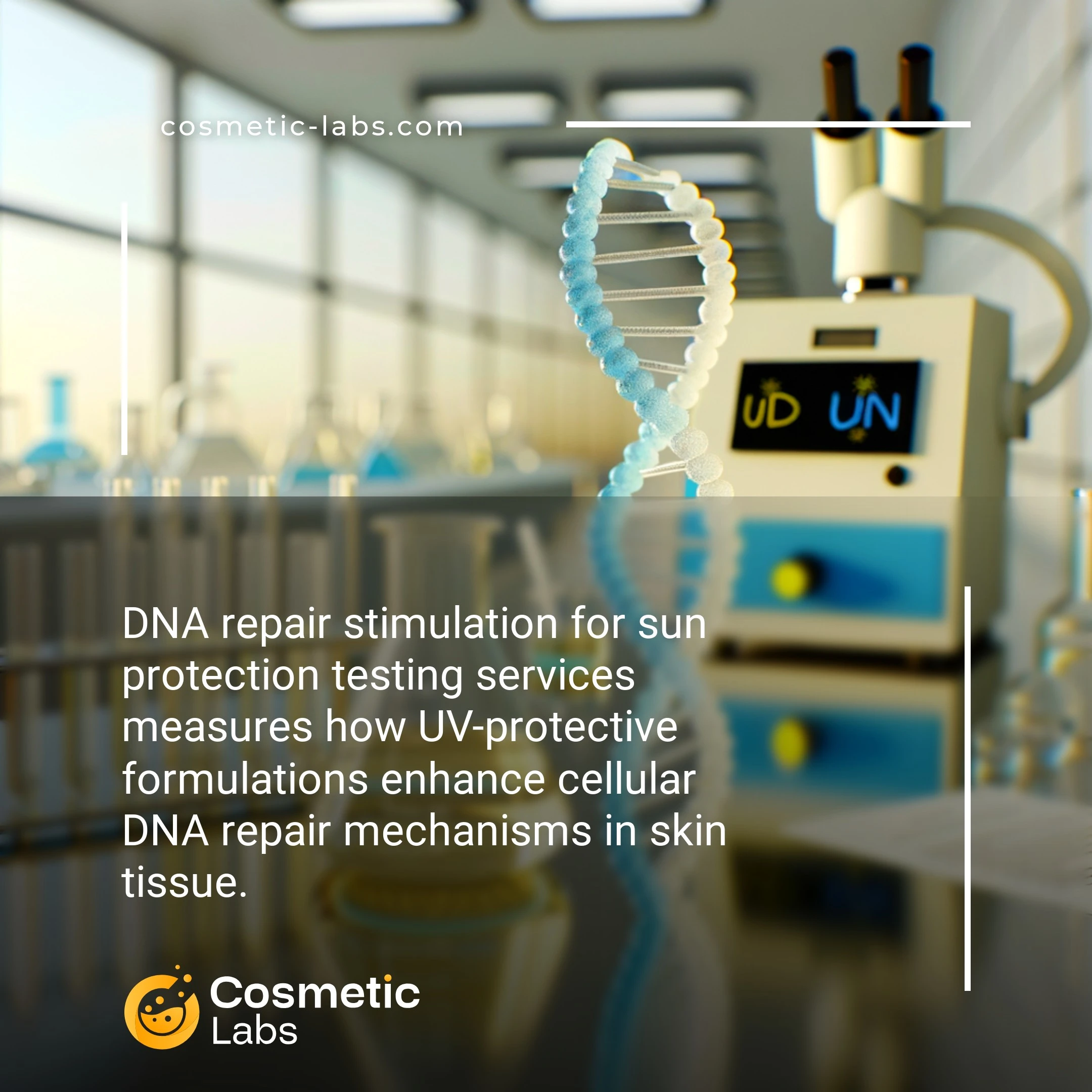DNA Repair Testing Services for Sun Protection Products

What is DNA repair stimulation?
DNA repair stimulation testing for sun protection measures how cosmetic formulations enhance cellular DNA repair mechanisms after UV exposure. Labs use specialized assays like comet testing and cyclobutane pyrimidine dimer analysis to quantify your product’s ability to accelerate skin cell recovery from photodamage. This testing reveals whether active ingredients like photolyase enzymes or antioxidant complexes actually boost the skin’s natural repair processes, providing scientific validation beyond standard SPF measurements for premium anti-aging suncare claims.
Why do you need this service?
Beauty brands use DNA repair stimulation testing to validate anti-aging sunscreen formulations that protect against photoaging while repairing cellular damage. Our partner labs measure cyclobutane pyrimidine dimer reduction rates and 8-oxoguanine repair efficiency in human keratinocytes, delivering quantifiable proof of DNA protection for marketing claims and regulatory submissions within 2-3 weeks.
Who provides DNA repair stimulation services?
All cosmetic labs providing DNA repair stimulation services
There is no company providing these services at the moment.
DNA Repair Stimulation Testing for Sun Protection Products
Labs evaluate how well cosmetic formulations activate cellular DNA repair mechanisms after UV exposure. This testing measures your product’s ability to enhance skin’s natural recovery processes beyond basic UV filtering.
Cellular Repair Pathway Analysis
Testing facilities use DNA repair stimulation assays to quantify how active ingredients trigger cellular recovery mechanisms. Labs expose cultured skin cells to controlled UV doses, then apply your formulation to measure repair protein activation.
Key measurements include:
- DNA damage marker reduction (8-oxoguanine levels)
- Repair enzyme activity (photolyase, glycosylase)
- Cell viability recovery rates within 24-48 hours
This data helps validate claims about post-sun repair benefits and cellular protection enhancement.
Photoprotection Enhancement Validation
Labs combine DNA repair testing with traditional SPF measurements to demonstrate dual-action protection. Testing protocols evaluate both immediate UV blocking and subsequent cellular recovery support.
Standard testing includes:
- Pre-exposure product application on cell cultures
- Controlled UV irradiation at specific wavelengths
- Post-exposure repair monitoring for 72 hours
Results show whether your formulation provides synergistic protection through both prevention and repair mechanisms. Connect with specialized labs on our platform to design testing protocols that support your product’s unique positioning in the sun care market.
Practical Applications of DNA Repair Stimulation Testing for Sun Protection
Cosmetic brands use DNA repair stimulation testing for sun protection to validate photoprotective claims and differentiate their products in competitive markets.
Anti-Aging Sunscreen Development
Labs measure DNA repair activity in keratinocytes and fibroblasts after UV exposure to evaluate sunscreen formulations targeting mature skin. Testing protocols examine cellular recovery rates within 24-48 hours post-irradiation using comet assays and cyclobutane pyrimidine dimer quantification. Brands developing premium anti-aging SPF products rely on these metrics to support marketing claims about cellular protection beyond traditional SPF measurements.
Results guide ingredient selection for DNA repair enhancers like photolyase enzymes, antioxidant complexes, and botanical extracts. Testing identifies optimal concentrations that demonstrate measurable repair stimulation without compromising product stability or user experience.
Daily Defense Product Validation
Cosmetic companies test moisturizers, serums, and makeup with SPF claims using DNA repair assays to substantiate daily protection benefits. Labs expose cultured skin cells to simulated solar radiation, then measure repair enzyme activity and DNA damage markers over 6-72 hour periods. This testing validates products marketed for everyday photoprotection and skin health maintenance.
Brands use these results to position products beyond basic sun protection, demonstrating active cellular repair mechanisms. Testing data supports claims about cumulative damage prevention and long-term skin health benefits that resonate with health-conscious consumers.
| Testing Method | Primary Measurement | Timeframe | Application |
|---|---|---|---|
| Comet Assay | DNA strand breaks | 2-24 hours | Immediate repair assessment |
| CPD Quantification | Pyrimidine dimer formation | 24-48 hours | UV-specific damage evaluation |
| Enzyme Activity | Repair protein function | 6-72 hours | Cellular response validation |
| Gene Expression | Repair pathway activation | 12-48 hours | Mechanistic understanding |
Ready to validate your sun protection formulations with DNA repair testing? Connect with experienced cosmetic labs on our platform to discuss your specific testing requirements and timeline.
